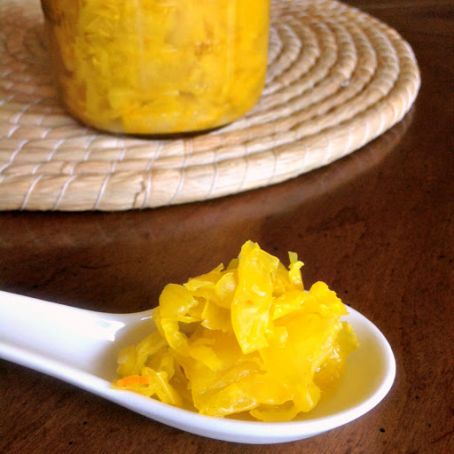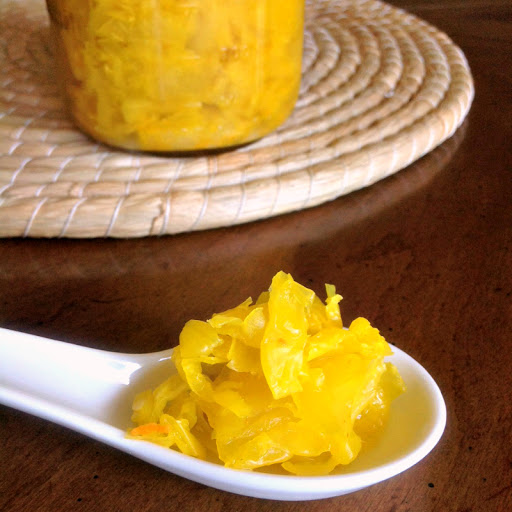Ginger Turmeric Sauerkraut
By erinstargirl
This Ginger Turmeric Sauerkraut is an anti-inflammatory probiotic-rich kraut!
 1 Picture
1 Picture
Ingredients
- 1 pound organic green cabbage, unwashed {the natural bacteria is good for fermentation process}, outer leaves and core removed, sliced thin {save one or two nice outer leaves for helping to weigh down the veggies}
- 1-2 inch long section of organic ginger root, peeled and grated
- 1-2 inch long section of organic turmeric root, peeled and grated
- 1 scant TB sea salt {13 grams}
- Supplemental brine, if needed
Details
Servings 2
Preparation time 20mins
Preparation
Step 1
Combine the sliced cabbage, ginger, turmeric, and salt in a large glass bowl. With clean hands punch down, squeeze, and manipulate the cabbage mixture. You'll notice more liquid in the mixture as the salt draws water out of cabbage. Continue this for another 10 or so minutes until the mixture is soft. When you push the mixture down, you should notice juice rising to the top.
Ladle cabbage mixture and brine into clean Mason jars, leaving about 2" headspace. If you need extra brine, mix 1/2 cup filtered water with 1/2 tsp sea salt and use as needed.
Below brine is key! Veggies exposed to oxygen will grow mold. The brine protects the veggies so you want to weigh the mixture down under the brine. A spare cabbage leaf sprinkled with a pinch of sea salt will help keep any of the determined tiny shreds below the brine. Place this down first, then add a Crock Rock weight over the cabbage leaf, and press down until fully submerged. The brine should cover the mixture by at least one inch.
During the fermentation process, gases are created - they need a place to go. Covers that let the gas escape while keeping oxygen exposure minimal are ideal. Kraut Kaps are fantastic for eliminating oxygen exposure but also letting the gas out.
Let your ferment sit at room temperature {68-72 degrees F, warm but not humid} dark location. Be sure to occasionally check for signs of mold. Kahm yeast {white in color, no dark color /black or fuzzy growth it it} is NOT the same as mold. The sauerkraut can ferment for 3-4 weeks even upwards of 12 weeks - it depends on where you live, and even to your taste. Store in the fridge where it will keep well for several months, if it lasts that long...

Review this recipe